Menus
- What you must remember
- Themore
- Theless
- Prices
- Make yourYamaha YZF-R6 600 2013
- Opinion
- Replaces
- Performances
- The technical aspect
- Competitors
- Gallery
- Related articles
Still no changes for the R6, which is entering its 5th season in Supersport (the 2010 evo marked too few changes to be significant). Aging in the calendar, she nevertheless loses nothing of her charisma. Tracking to the end of the rods, the magic of the R6 is still alive and well, even more after the 2010 update. Don’t look at the design side, you won’t see a thing – it’s all about the mechanics. The longer exhaust by ten centimeters made it possible to get in tune with the level of pollution control and to improve the flow of gases at the outlet. Yam worked a lot on the air intake and electronic engine management. A larger air box ate 1/3 of a liter from the tank. But these modifications give 10% more torque and better availability at mid-range. On the scale, it bumps a bit and the R6 takes 4 kilos.
Being the most extreme 600 sportswoman does not exempt you from undergoing an ungrateful but essential law: evolution. And even when our name is R6, we are no exception. But Miss Pistarde is hardly worried. With the Yamaha engineers who looked into it and an incredibly formidable potential on the track, the 2010 – 2013 version of this furious 600, like the 2008, will continue to delight many..
Let’s go back to its genesis, which basically dates from 2008. Technology enthusiasts will appreciate it. After adopting the YCC-T (drive by wire) throttle control system, the R6 swooped in 2008 to its sister R1 with the YCC-I (Yamaha Chip-Controlled Intake) variable intake. A set in the air box that allows you to modify the length of the intake horns.
All the cones are divided into 2 sections, the top one being mobile, actuated by a servomotor itself controlled by electronics. At low speeds, to improve torque, the horns are separated and air passes through the lower section, resulting in short intake manifolds. The engine response to acceleration is thus better.
Higher in the towers, at a certain speed, the upper section lowers and covers the base cones. As a result, the intake pipes are longer and provide more gniak in high revs. Since a modification of the air box is essential, its orifice has also been improved to reduce air resistance..
 To better manage this cocktail of electronics and admission, Yamaha took the opportunity to review the settings of the YCC-T and the injection. Especially since the engine manufacturers have added patator in the boiler.
To better manage this cocktail of electronics and admission, Yamaha took the opportunity to review the settings of the YCC-T and the injection. Especially since the engine manufacturers have added patator in the boiler.
13.1 to 1, does that mean anything to you? This is the compression ratio in the cylinders of the R6. Quite simply the highest rate ever adopted on a production Yam. With 12.8 to 1 on the old model, it was already compressing quite a bit. But there, it became very strong. This was made possible thanks to new high compression pistons. Distinctive point: their slightly convex shaped caps allow a combustion chamber with a “sloping roof”.
The internal modifications do not stop there: the recesses of the cylinder head have been dug to accommodate the four ultra-light titanium valves. To cope with the increased loads created by these new pistons, the connecting rod bearings have been widened and the main bearing grease hole has been revised. In addition, the intake and exhaust valve springs are now made from a more enduring alloy which guarantees the consistency and efficiency of the valves in extreme driving conditions on the circuit. The timing chain tensioner is treated with palladium carbide to harden its surface and ensure consistent chain performance.
On the exhaust side, the intermediate silencer housed at the outlet of the tubes of the 2nd and 3rd cylinder is widened by 30%, still in order to improve the torque at low speeds.
 That was the technical side. Question pure power, the R6 lost a few horses in 2010 (who knows why) to develop since some 124 horses. An already muscular hara, hysterical in the towers, but which loses a little nobility in the face of the trailer of the ex-grind and its 135 horsepower obtained at 14,500 rpm (129 without the forced air intake ). The power that a 750 developed not too long ago. Except that today, around this power, there is an EXUP, titanium valves, an anti-dribble, a Drive by wire YCC-I handle, a YCC-T variable admission, and a chassis that has it also evolved.
That was the technical side. Question pure power, the R6 lost a few horses in 2010 (who knows why) to develop since some 124 horses. An already muscular hara, hysterical in the towers, but which loses a little nobility in the face of the trailer of the ex-grind and its 135 horsepower obtained at 14,500 rpm (129 without the forced air intake ). The power that a 750 developed not too long ago. Except that today, around this power, there is an EXUP, titanium valves, an anti-dribble, a Drive by wire YCC-I handle, a YCC-T variable admission, and a chassis that has it also evolved.
Thanks to its mastery of die-casting technology, Yamaha redefined the distribution of the frame’s rigidity by changing the wall thickness of the two side beams by touch, especially at the level of the rider’s knees. At the same time, the wall of the steering column has been thickened in order to gain rigidity, while the cross member that connected the left and right sides of the Deltabox frame has disappeared on the model since 2008, as had been the case on the R1 2007 model..
These changes are almost impossible to see with the eye, but are supposed to improve handling and increase the precision of the R6 when cornering. In this regard, nothing is left to chance: the new fork sleeves also benefit from a differently distributed rigidity, a new lower triple tree, and an extended triple clamp offset. On this formidable front axle, the braking remains the excellent 310 mm double disc with 4-piston radial calipers; the only change comes from the thickness of the discs, going from 4.5 to 5 mm.
You were familiar with magnesium as the material used for housings, or certain parts of the frame. On the R6, it is also used for the rear loop of the c adre. And hop, 450 grams of gained at this place. Underneath, there are sections of the swingarm that are no longer extruded but forged aluminum. A few centimeters away, the rear suspension has been lightened via a new compression adjustment support, as on the R1 2007-2008 version. And yet, the R6 has gained weight. 5 kgs in 2 years, to settle in 2008 at 166 kgs dry. – and still 4 kilos in the hips for 2010. For some time now, the crazy hunt for weight no longer seems to be the priority of manufacturers (except Honda and Ducati).
adre. And hop, 450 grams of gained at this place. Underneath, there are sections of the swingarm that are no longer extruded but forged aluminum. A few centimeters away, the rear suspension has been lightened via a new compression adjustment support, as on the R1 2007-2008 version. And yet, the R6 has gained weight. 5 kgs in 2 years, to settle in 2008 at 166 kgs dry. – and still 4 kilos in the hips for 2010. For some time now, the crazy hunt for weight no longer seems to be the priority of manufacturers (except Honda and Ducati).
When you step on it, you will realize that the changes affect you too. The riding position is advanced by 5 mm and the half-handlebars descend by the same amplitude. Low values but which should make it possible to become even more united with the machine … and to be a little more terrified of each “cushy” ride.
On the aesthetic side before and after 2010, it is subtle and yet, the R6 has still gained (a little bit) in dynamism. But it will be necessary to be really attentive to distinguish that the upper edges of the sides have been redesigned, that the point of attachment of the mirrors is modified a tad, that the new bubble caps an even sharper beak, and that we have a tad reviewed the top of the tank. Flickers, but a design that is still incredibly aggressive and decidedly irresistible: as if adrenaline had guided the draftsman’s pencil.
Dazzlingly efficient on the track, the YZF-R6 intends to hold the outposts for a long time to come. A small aesthetic touch-up, even more electronics and technological aids, more watts, a still optimized chassis … Even with her age, Miss R6 continues to express her exceptional efficiency on numerous circuits and competitions..
What you must remember
Themore
Theless
Prices
12,799 €
Price
nine
Compare
the credits
Make
yourYamaha YZF-R6 600 2013
Estimate, calculate and compare the cost of insuring your motorcycle.
Calculate the cost of
insurance
Test the price of the motorcycle insurance specialist
Opinion
on 6 opinion
users
Read the reviews
Replaces
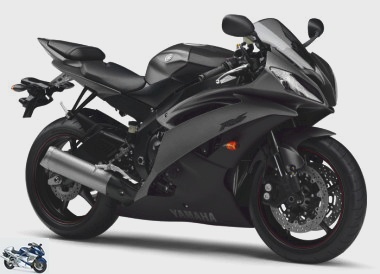
YZF-R6 600 2012
Model marketed in
2010
2011
2012
2013
2014
2015
2016
Performances
-
Max speed:
about 270 km / h
The technical aspect
Yamaha YZF-R6 600 2013
- Frame
- Frame: double aluminum beam deltabox
- Tank: 17 liters
- Seat height: 850 mm
- Length: 2,040 mm
- Width: 705 mm
- Height: 1,100 mm
- Wheelbase: 1380 mm
- Dry weight: 170 kg
- Operating weight: 189 kg
- Train before
- Telehydraulic inverted fork Ø 41 mm, deb: 115 mm
- 2 discs Ø 310 mm, 4 piston calipers radial fixing
- Front wheel:
120/70
– 17
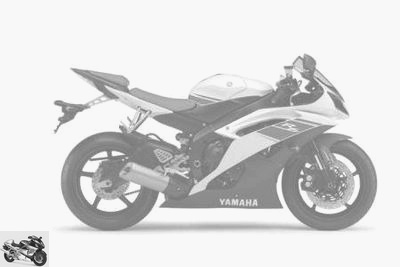
- Transmission
- 6-speed gearbox
- by chain
- Rear axle
- single shock absorber, deb: 120 mm
- 1 disc Ø 220 mm, 2 piston caliper
- Rear wheel:
180/55
– 17
- Motor
- 4 Cylinders
in line
, 4 stroke - Cooling: Liquid cooling
- injection
- double ACT
- 4 valves per cylinder
-
600 cc
(67 x 42.5 mm) -
124
ch
at 14,500 rpm - 135 hp with forced air
-
6.70 mkg
at 11,000 rpm - Weight ratio /
power
: 1.37
kg / hp - Compression: 13.1: 1
- Crit’air:
Detached pieces
exhaust
motor
fluid
electricity
filtration
braking
chain kit
Competitors
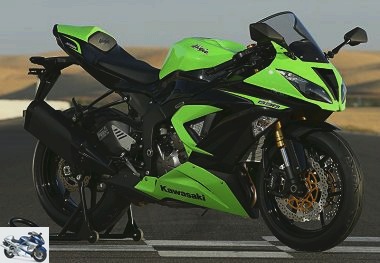
Kawasaki ZX-6 R 636 2013
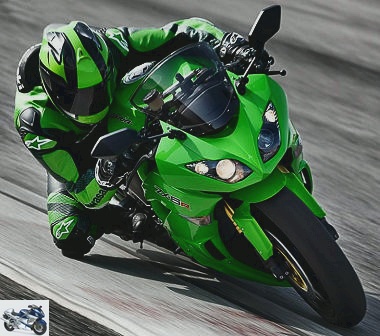
Kawasaki ZX-6R 600 2013
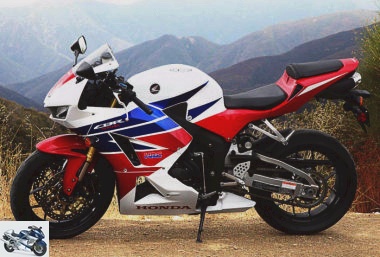
2013 Honda CBR 600 RR
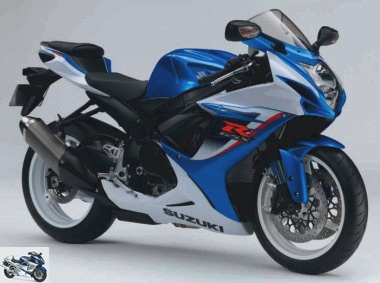
Suzuki 600 GSX-R 2013
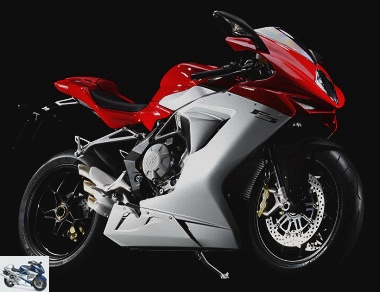
MV-Agusta F3 675 2013

Triumph 675 Daytona 2013
Gallery
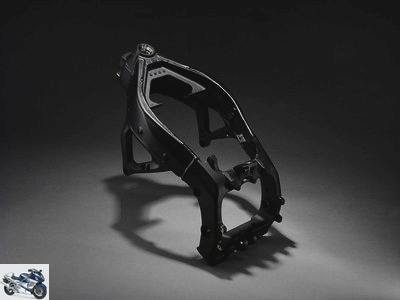
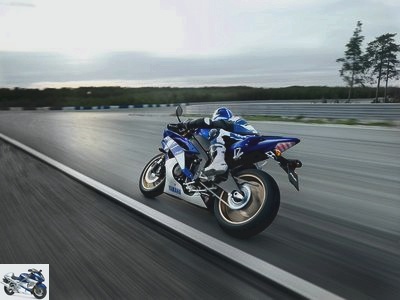
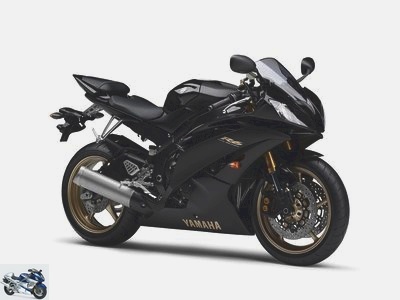
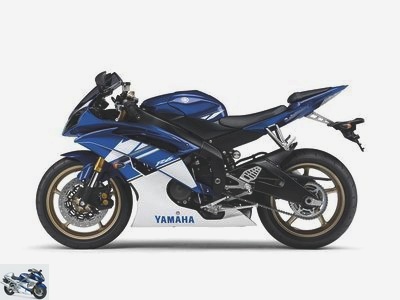
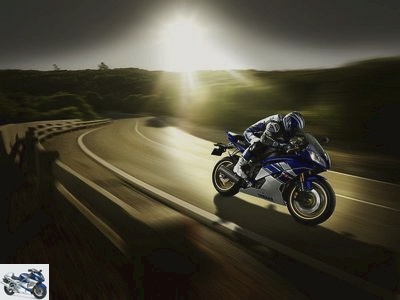
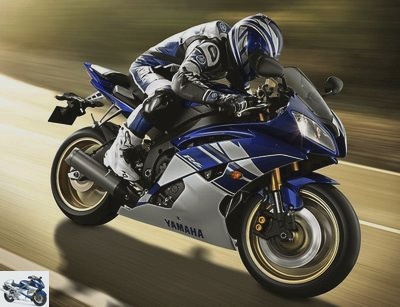
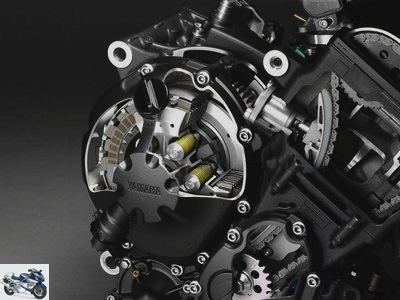
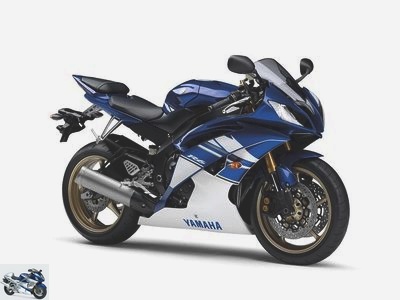
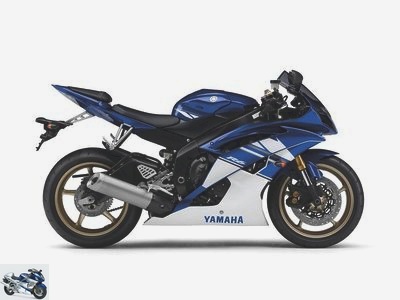
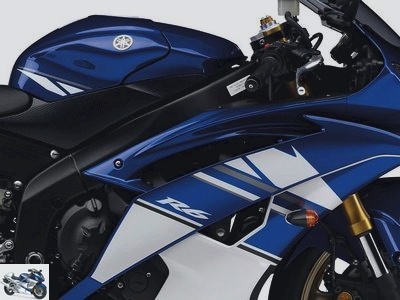
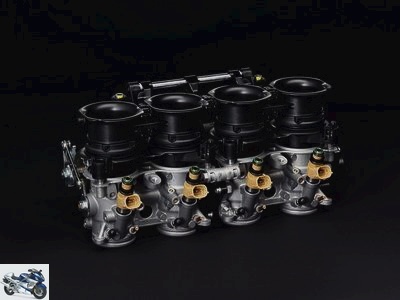
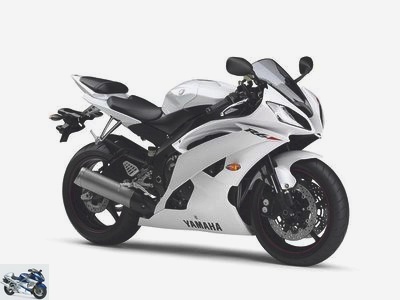
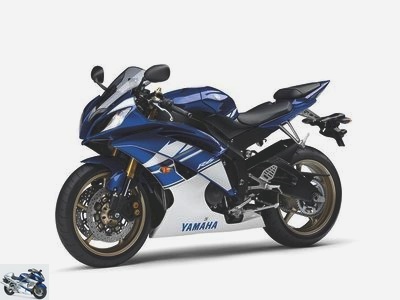
Related articles
-
Retaining its evolutionary cycle, the 2010 R6 cuvee is improving for this new vintage … But the modifications are far from spectacular. Don’t look at…
-
Being the most extreme 600 sportswoman does not exempt you from undergoing an ungrateful but essential law: evolution. And even when our name is R6, we…
-
Still no changes for the R6, which is entering its 6th season in Supersport (the 2010 evo marked too few changes to be significant). Aging in the…
-
No changes for the 2012 R6, apart from an Akrapovic exhaust as a bonus, and a superb motoGP replica colorway with the limited series WGP 50th…
-
Retaining its cycle of evolution, the 2011 R6 cuvee remains identical to the previous vintage, the overhaul not to take place until 2012. But the recent…
-
Yamaha YZF-R6 600 WGP 50th Anniversary 2012
The most pistarde of the Yamaha will know only one evolution in 2012: the colors. And especially this superb WGP 50th anniversary. In 2012, the tuning…
-
What longevity for the R6! Yamaha’s supersport has been in the catalog for 8 years without any real changes (the 2010 evo marked too few changes to be…
-
Still no changes for the R6, which is entering its 7th season in Supersport (the 2010 evo marked too few changes to be significant). Aging in the…
-
Being the most extreme 600 sportswoman does not exempt you from undergoing an ungrateful but essential law: evolution. And even when our name is R6, we…
-
The YZ 250 F renews its confidence in a good old carburetor to feed its mono, even today when all the competing machines in 4T have switched to…